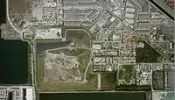

 The Medley Landfill is a 170-acre regional landfill with a waste flow of approximately 3,000 tons per day. The landfill is located in Miami-Dade County, Florida, and is owned and operated by Waste Management, Inc.
The Medley Landfill is a 170-acre regional landfill with a waste flow of approximately 3,000 tons per day. The landfill is located in Miami-Dade County, Florida, and is owned and operated by Waste Management, Inc.
SCS Engineers has performed numerous projects at Medley Landfill since 1998. Many of these projects have a liquids management component in the design, permitting, and/or construction phase of the work. A brief description of some of these liquid management activities are described below:
Leachate Pre-Treatment Facility
SCS developed a conceptual design followed by a final design of an expansion to an existing pre-treatment facility at Medley Landfill. The expansion significantly increased treatment capacity to accommodate for the increase in leachate volume generated from the larger landfill footprint as a result of a few lateral expansions. The pre-treatment plant was specifically required by the facility permit to reduce ammonia concentrations in leachate to below 100 ppm before discharge to the sewer system. The expansion design was permitted through the Florida Department of Environmental Protection (FDEP).
Deep Injection Well
SCS currently provides consulting services for regular monitoring and reporting of an existing deep injection well on site. Leachate generated at the landfill is injected into the deep well in accordance with the permit issued by the FDEP. The deep well is over 3,000 ft and is connected to the boulder zone significantly below the existing aquifers. The deep injection well was constructed in 2012 and SCS has since had the responsibility of managing sampling, laboratory analysis of samples collected from a monitoring well as deep as the injection well, and preparation of reports for submittal to FDEP.
Temporary Caps
SCS has designed and provided monitoring services during installation of a 25-acre temporary geomembrane cap over a portion of the landfill intermediate slopes. The purpose of the temporary cap was to reduce leachate generation, reduce odors, increase gas collection efficiencies, and address leachate seeps on the slope. The projects was a success in all aspects. The temporary cap is scheduled to be removed in stages as a lateral expansion adjacent to the slope covered with the temporary cap is being developed and filled over time.
Final Covers
SCS has designed, permitted, and provided monitoring services during construction of four partial closure projects at Medley landfill. The partial projects are implemented as landfill slopes reach final grades. The final covers are equipped with leachate toe drain systems below the final cover geomembrane, and rainwater toe drain systems above the final cover geomembrane. The leachate toe drain systems collect and dispose of any leachate seeps below the final cover geomembrane in an effective manner. The leachate toe drain system also provides the means to collect gas from the lower portion of the slope after completion fo the final cover system. Rainwater toe drain systems effectively collect rainwater that percolates through the upper soil layer of the final cover into the final cover drainage layer. The water is collected and diverted to the landfill perimeter ditch through an engineered system that prevents pore pressure build up in the final cover and keep the system in stable condition.
The final cover system includes tack-on swales to catch runoff from higher elevations and convey water to downchute pipes. The location of tack-on swales, and position of the downchute pipes are flexible and can easily be adjusted to the size of each partial closure and overall management of storm water around the site.
Storm Water Management System
SCS had designed, permitted and constructed a significantly complicated stormwater management system for the entire Medley facility. Due to the specific location of the site within the regional watershed, the entire 100-year, 72-hour storm falling on the entire facility must be retained on site with zero discharge. Designing such a system required significant modeling and utilizing innovative measures. With each lateral expansion of the landfill footprint that was envisioned by the owner and designed and permitted by SCS, the stormwater system had to be redesigned at the site-level to accommodate the larger quantity of runoff reaching the landfill perimeter system. The storm water system consists of perimeter horizontal dry retention ditches interconnected with the dry retention area before overflow to an on-site wet retention area. The design includes 100 percent runoff from the landfill slopes, which is the most conservative case for managing storm water around the site. Percolation of storm water into the surficial aquifer through dry and wet retention areas was incorporated into the stormwater model in a very innovative manner.
The storm water system consists of perimeter horizontal dry retention ditches interconnected with the dry retention area before overflow to an on-site wet retention area. The design includes 100 percent runoff from the landfill slopes, which is the most conservative case for managing storm water around the site. Percolation of storm water into the surficial aquifer through dry and wet retention areas was incorporated into the stormwater model in a very innovative manner.